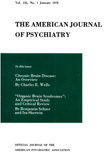Wrist-Cutting Syndrome: The Meaning of a Gesture
Abstract
The phenomenon of repeated wrist cutting in young women, performed in a nonsuicidal manner, was studied through the use of a control group. Histories revealed a significant incidence of early physical illness and surgery and markedly abnormal patterns of menstruation. The subjects interviewed immediately after cutting described an inability to deal with specific feelings, leading to a state of depersonalization. They cut themselves in an effort to reintegrate, and seemed to know exactly what was necessary to accomplish this: seeing a certain amount of blood, feeling a degree of pain, or being able to look inside the gaping wound. The authors relate the wrist-cutting gestures to genital conflict, reactions to helplessness, and an inability to handle aggression.
Access content
To read the fulltext, please use one of the options below to sign in or purchase access.- Personal login
- Institutional Login
- Sign in via OpenAthens
- Register for access
-
Please login/register if you wish to pair your device and check access availability.
Not a subscriber?
PsychiatryOnline subscription options offer access to the DSM-5 library, books, journals, CME, and patient resources. This all-in-one virtual library provides psychiatrists and mental health professionals with key resources for diagnosis, treatment, research, and professional development.
Need more help? PsychiatryOnline Customer Service may be reached by emailing [email protected] or by calling 800-368-5777 (in the U.S.) or 703-907-7322 (outside the U.S.).



